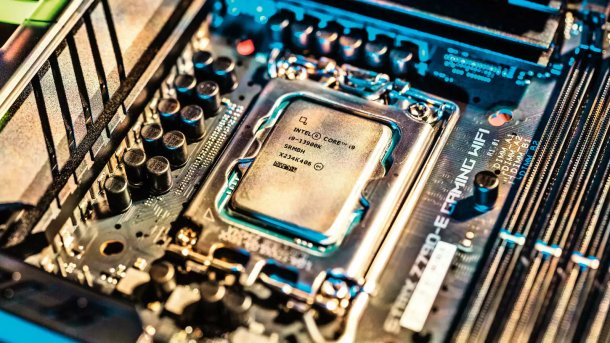Intel's solution for unstable CPUs: Keep to the specifications!
Core processors of the 13th and 14th gen are increasingly crashing. According to Intel, this is due to extreme factory overclocking by main board manufacturers.

This Core i-9 13900K can also run unstably when automatically overclocked by the mainboard.
(Bild: c't)
In a statement to external hardware developers, Intel describes what a workaround against the frequent instabilities of its current and last generation of desktop CPUs might look like: The firmware of the mainboards must simply set the values that Intel has also provided in its specifications for the processors.
This sounds like a matter of course, but it is a clear warning to board manufacturers not to overload the CPUs of the 13th and 14th core generation with overclocking functions. This applies to all processors with the K suffix, such as the current top model Core i9-14900KS. Intel has increased the maximum power consumption for the second of the two power limits, PL2, from 253 to 320 watts compared to the 14900K.
This provides a few percent more computing power, but ensures persistently high temperatures and currents in the silicon. If all limitations in the BIOS or UEFI are removed, the 14900KS can even reach a power consumption of over 400 watts. Even with very good cooling, no processor can withstand this in the long term, which can be seen in games and other applications with crashes. Windows then displays error messages that are not relevant, such as for the graphics memory, but in reality the problem lies with the processor – even if it is a different K model.
Mainboards remove limitations ex works
In the statement, which was first published in full by Igor's Lab, Intel clearly points out that preset values in the BIOS are responsible for these effects: "Intel has observed that motherboards with 600- and 700-series chipsets often set BIOS defaults to disable thermal protections and power supply protections that are designed to limit processor stress from sustained periods of high voltage and frequency." What follows is a list of numerous parameters that experienced overclockers have had to set manually in order to run processors completely unrestricted.
As Intel literally "clearly recommends" to its partners, the limits for clock speed, power consumption and temperature in the BIOS default settings should be adhered to. If there is an option to override these limits, the user should be warned of the risks. This is not the case with many current main boards; there are terse options such as "Multi-Core Enhancement" on the home page of the firmware. If this is activated, numerous parameters of the CPU configuration can be set in such a way that the limitations are lifted.
In an earlier recommendation to board manufacturers, the chip manufacturer already called for an "Intel Baseline Profile" in which the specifications are adhered to. Without much explanation, companies such as Asus and Gigabyte have also made this available through updates recently, but not for all models of their motherboards. As always, however, these new BIOS versions must also reach users and, if necessary, be installed manually.
As Intel also clearly states in its statement, the root cause of the crashes has not yet been found. The company is currently investigating affected copies of the processors. The chip manufacturer's statement is an indication that the internal protection mechanisms of the CPUs may no longer function during or after such extreme overclocking. Numerous sensors in the chips are supposed to ensure that the voltage, clock and frequency are automatically regulated when limit values are exceeded so that the system runs stably.
(nie)